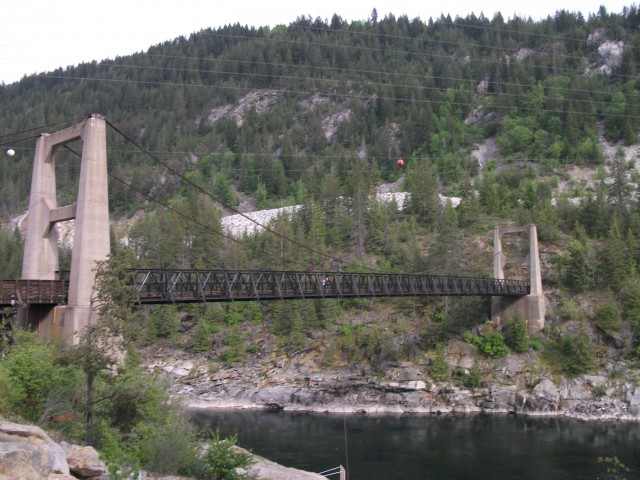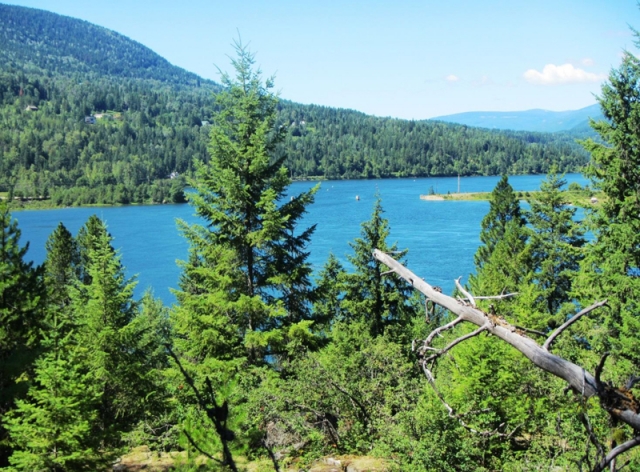Saturday an historic day for Castlegar
A fundamental piece of Castlegar heritage will once again be accessible to the public after this weekend’s grand re-opening of the Brilliant Suspension Bridge.
The bridge stands as testament to the pioneering spirit of the region’s early settlers – and as a symbol of the hopes, dreams and strategies that will guide the region’s future.
Larry Ewashen, local historian and curator of the Doukhobor Discovery Centre, says the bridge was built with hand-made tools, without benefit of heavy equipment or electricity – and from plans the builders couldn’t even read …they had to work from the pictures.
“The workers – who were functionally illiterate and whose only language was Russian – were faced with blueprints drawn up in English,” Ewashen explains. “According to (one witness), ‘they saw it and built from it’.”
Despite the barriers, 40 men worked 11-hour shifts for seven months 9with no pay, in keeping with the communal lifestyle) to create what was, in 1913, was a technological marvel.
“As a monument, it is a reminder of the three people who died working on the project, and at least seven others who were severely injured,” Ewashen adds.
According J.J. Verigin, executive director of the USCC (the organization representing local Doukhobors) the bridge was built for everyone, not just those of Doukhobor descent, to use.
“It was a stunning accomplishment, from a construction perspective and from a technological perspective,” says Verigin. “Bridges serve as powerful symbols … bridging the past and the future, and bridging the gap between ethnic communities, faith traditions …bringing everyone together.”
The technological marvel he’s speaking of is the Doukhobor’s use of a cutting edge advancement for 1913 – reinforced concrete – a technology that may well be the reason the bridge has stood the test of time and remains standing nearly a century later.
“The bridge continued to serve the public until 1966, when the new bridge was built (by the B.C. Ministry of Transportation),” Ewashen says. “It was used for pedestrian traffic until it deteriorated to such a degree that it was barricaded to prevent further use.”
In that time, the bridge played a huge role in the commerce and mobility of the region – and was pivotal in some of the area’s more lurid historical events. For example, one of the last men to be executed by hanging in B.C. was accused of murder in 1951. He threw the murder weapon off the Brilliant Bridge and into the Kootenay River, where police recovered it and used it as evidence to help convict the man. He was hanged on Dec. 11, 1951.
Today, plans around the bridge have more positive connotations – regional district director Gord zaitsoff said he sees it as a tourist hub with enormous potential as a jumping-off point (no pun intended) for further tourism attractions.
“Obviously, it’s going to be a key attraction of the TransCanada Trail system,” he said. “Our next step is to see a viewing platform, and we want to develop a parking area down there with a couple of picnic table – spruce it up as a place families will want to spend some time together.”
He says the bridge will complement other projects on the go in theBrilliant and Ootischenia flats, and his vision one day includes a massive community garden, interpretive centres, and more – all of which are in keeping with the key area goal of diversifying the local economy.
The restoration project also represents years of work on the part of committee members, past and present, and came in at a fina tally of roughly $1.2 million.
Columbia Power has donated money to see the bridge illuminated from dusk until dawn, promising a stunning addition to Castlegar’s night-time skyline, while increasing safety.
Re-opening ceremonies are open to the public and will begin this Saturday at 10 a.m. at the Brilliant Cultural Centre (for more information, call 250-365-3613).
To learn more about this remarkable piece of local history, check out the bridge website at http://www.brilliant-bridge.ca
To give credit where it’s due, a number of organizations donated vast sums of money to bring this project to fruition ( list courtesy Jim Crockett, director of recreation):
Local Motion $451,000.00
Columbia Basin Trust $200,000.00
National Trails Coalition $193,053.00
Area J – Gord Zaitsoff, Director $150,000.00
Ministry of Transportation $150,000.00
Area I – John Voykin, Director $ 43,000.00
Community Tourism, UBCM $ 41,610.00
Heritage Credit Union $ 25,000.00
Kootenay Savings $ 20,000.00
BC Hydro $ 3,250.00
























Comments